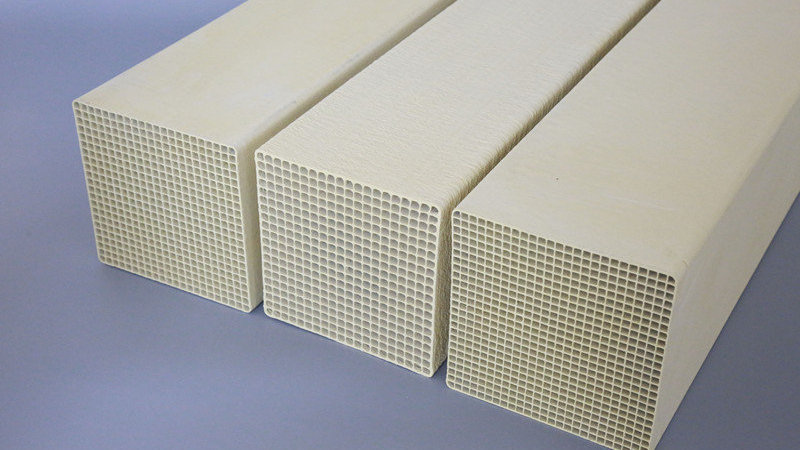
The denitrification catalyst is an important part of the SCR denitrification system and directly affects the denitrification efficiency. The composition of denitrification catalysts varies for different flue gas conditions, what factors should be considered when designing the catalyst scheme?

1. Flue gas volume (generally using standard wet)
The standard condition or working condition (with corresponding temperature), affects the total volume of the catalyst and the way the module is arranged (controlling the flow rate). Generally, in the design of the program, the standard wet flue gas volume is used. If the standard wet is not specified, the default is standard wet. If the standard dry flue gas volume is given, it is converted to standard wet flue gas volume: for example, if the moisture is 10%, the standard dry flue gas volume/(1-0.1) = standard wet flue gas volume.
2、Denitrification operation temperature
The active temperature window of denitrification catalyst is 300~400℃. If the reaction temperature is too low, it will reduce the activity of the catalyst and make the denitrification efficiency drop, and finally the denitrification effect will not be achieved. If the catalyst continues to operate at low temperature, it will lead to permanent damage of the catalyst; if the reaction temperature is too high, NH3 will be easily oxidized and NOx will be generated, which will affect the denitrification efficiency and even cause phase change of the catalyst material, resulting in the degradation of the catalyst activity. Especially, the temperature range of long-term operation affects the selection of catalyst and the number of cubic meters.
3. Dust content
Directly affects the selection of catalyst pore number.
4、Inlet NOx
With a certain volume of catalyst, the load inside the catalyst pore is gradually increasing with the increase of inlet NOx concentration, which leads to the decrease of denitrification efficiency of the catalyst. Therefore, the concentration of inlet NOx directly affects the total number of cubic meters of the catalyst.
5、Outlet NOx requirement
affects the total cube number of catalyst.
6、Ammonia escape requirement
The volume fraction of NH3 in the outlet flue gas reflects the NH3 that does not participate in the reaction. By analyzing the NH3 escape rate, the process of catalytic reaction and the efficiency of catalytic reaction can be grasped. If the escape rate of NH3 is too high, it will increase the production cost. Therefore, the correct analysis of NH3 escape rate has a direct impact on the analysis of the catalytic reaction effect and meeting the reaction needs. It is generally 3ppm when the scheme is designed.
7、SO2/SO3 conversion rate requirement
The conversion ratio of SO2 to SO3 in flue gas has an important influence on the whole catalytic reaction, and the higher the conversion ratio, the better the catalytic effect and the corresponding reduction in the amount of catalyst invested. At the same time, the analysis of SO2 and SO3 conversion rates can be used to understand the catalyst usage and the specific efficiency of the catalyst. Generally, it is reasonable to choose 0.4-0.5% for a single layer in the catalyst design.
8. Flue gas and dust composition
Due to the influence of flue gas and fly ash, the catalyst activity decreases gradually with the operation time: the deterioration rate is the fastest at the beginning of operation; after 2000h, the deterioration rate tends to slow down. In order to give full play to the residual activity of each catalyst layer and to maximize the use of the existing catalyst, the catalyst is usually arranged in an "X + 1" pattern, with X layers initially installed and one layer reserved. It should be emphasized that for the economical operation of SCR, it is advisable to consider selecting a catalyst with a wall thickness of not less than 0.8mm for future cleaning or regeneration techniques to extend the catalyst life.
In addition, the number of pores and layers required and the reactor size should be considered when designing the denitrification catalyst scheme.

Anhui Yuanchen Environmental Protection Technology Co., Ltd (hereinafter referred to as "Yuanchen Technology" contact number: 17333203296) is a high-tech enterprise integrating R&D, production and sales of dust removal bags and denitrification catalysts. Over the past sixteen years, Yuanchen Technology has been focusing on environmental protection field, and now has 4 international PCT, 33 authorized invention patents and 77 invention patents in process, among which many products such as "dust removal and denitrification integrated technology products" have been awarded the Scientific Progress Award of Anhui Province. In the future, Yuanchen Technology will be guided by "becoming the guardian of global ecological environment", always rooted in environmental protection, and insist on the great cause of guarding the blue sky and white clouds. Leveraging on the national ecological civilization construction pattern, we will continue to deepen technology, optimize management, strengthen brand, refine industry, solidify advantages, and create synergistic value for industry through comprehensive and integrated governance and services.